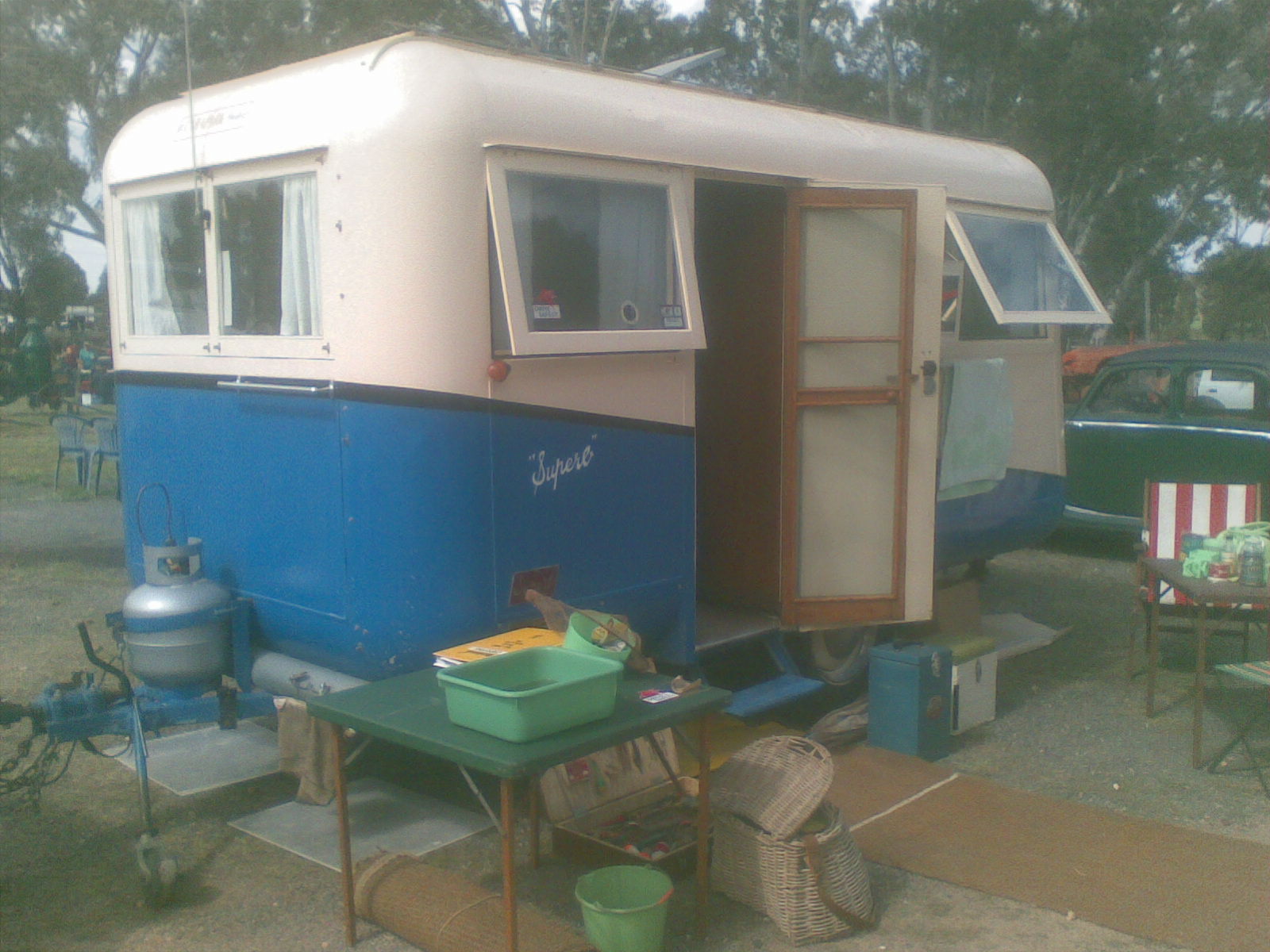Having always had Ford Prefects and Anglias, the move to the big Austin made me realise I could easily pull more than a little trailer so I had been looking for an old caravan for a little while. A friend mentioned that there one was available from the Salvation Army. It had been donated as emergency accommodation but required too much work so they decided to sell it.
This caravan saw the induction of Alan Stevens of Bendigo into the Vintage Caravan arena. The purchase and restoration of this caravan led to an ongoing hobby focussed around old caravans.
As soon as I saw it I knew it was exactly what I had been looking for. Towed it home and a close inspection showed most of the windows rotten, roof rusted through in places, no ceiling, wall panels missing, etc. However the timber fittings internally were in very good condition, including the ice chest. After some chasing, the past owners were located. Purchased new through their business in the late 1940’s by the Gill Brothers of Bendigo, it was shared by the families for holidays. It travelled much of Victoria and even the Snowy Mountains, in its first life and upon it’s second birth has been to Sydney, Canberra, Adelaide and Melbourne. I was then able to buy their original annexe and level riders. The unique annexe is ten feet wide and today would create problems in many of todays parks as sites are usually a standard eight feet wide. The annexe only required a few patches, new ropes and a couple of extra windows since originally it only had one window. The annexe attaches to the caravan roof via an aluminium rod using actual dog clips which are sown to the annexe.
Following purchase in September 1997, restoration commenced on the windows and continued to the van. As with any restoration job, you end up repairing more than you’d bargained on. While chasing further history on the caravan, a copy of an original Carapark sales brochure was kindly donated by Neil Chesney of Chesney Caravans. From his information I was able to replace parts and reproduce colours. The model turned out to be the first all steel Australian caravan built outside America and Carapark became extensive builders of caravans and trailers until moving into the Motel industry.
When I bought the caravan the best part was probably the seating but when I’d restored everything else, the upholstery looked very drab. Each cushion was like a small inner spring mattress and consisted of traditional inner springs, covered in horsehair and capock, plus deep buttoning. They required much hand stitching and the use of a huge semi circle needle to sow along the sides to re-create the cushioning effect.
The caravan was restored over a 6 month period. Alan located the original hand painted logos for “a Carapark Product” and was able to have them reconstructed for the front and rear of the caravan.
A 6 volt short wave radio which looks just like a 240 volt one, sits in the van and can apparently pick up Malaysia on a good night. Many relics from the 1950 era were collected at SWAP Meets and Opp Shops to use both functionally and for displays. It has won Show trophies for best exhibit.- coir matting, canvas stretcher, food safe, round card table, Tilley lamp, canvas camp seats, old jug, old toaster, etc.
The caravan is 13 feet long and weighs approx 1.1tonne, runs 16 inch Ford wheels and does have over ride brakes, but no handbrake. Alan now carries a couple of bricks to stop unplanned excursions once unhitched. The hitch is made of brass with what looks like a big wing nut on top. The jockey wheel is so skinny it looks anorexic.
The tow vehicle is a classic too and despite its likeness to an Austin Sheerline, it is really an Austin Princess. It is number 11 off the production line in 1947 and looks like it was sent to Vanden Plas prior to Austin upgrading the Sheerline to a Princess. The car has all the extras except the aluminium body and from speaking to various grey haired mechanics he concludes it was probably a proto-type and once completed, shipped to Australia so as not to confuse the English market.
The Princess has a 4.1 litre engine and weighing nearly 2 tonne it tows the caravan easily, but requires regular topping up of the 16 gallon fuel tank. The pair have travelled most of eastern Australia.
The caravan was sold to a collector in Woollongong NSW.












